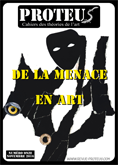Affects et imaginaire collectif dans la représentation de la blessure. Le corps mis en scène de Piotr Pavlenski.
Abstract
 Télécharger l’article
Télécharger l’article
Paru dans : Proteus n°11

C'est un détour par la catharsis grecque et le Zaubertrauer allemand (« enchantement-deuil ») que le philosophe Cornelius Castoriadis propose pour livrer sa pensée sur le rapport du sujet à l'œuvre d'art. Cet article tire les fils de Zaubertrauer pour éclairer la question de la radicalité des performances extrêmes sur le corps comme réponse à la « dilution » des dérives autoritaires des régimes politiques actuels, fondés sur la peur. Les mises en scènes du corps automutilé de l'artiste russe Piotr Pavlenski, instrument de défiance du pouvoir politique de Vladimir Poutine, sont ici notre objet d'étude. À travers celui-ci, nous explorerons le rôle des affects de pitié et terreur dans la catharsis ; nous examinerons comment leur potentiel radical, inscrit dans la représentation de la blessure et le signifiant de la douleur confronte l'imaginaire collectif de la société russe, et peut aussi ouvrir à un autre affect, celui de la fin du désir contenu dans le terme « deuil » (Zauber) chez Castoriadis. Cet article suggère que le pouvoir subversif de l'art extrême ne serait pas seulement à chercher dans la puissance perturbatrice de la mise en scène du corps mutilé, mais dans la possibilité de projeter le spectateur dans une temporalité qui déborde l'ici et maintenant de l'irruption de la performance.
Mots-clés : performance — Castoriadis — catharsis — automutilation — culture russe
In Window on the Chaos, Cornelius Castoriadis gives an original account of the role and catharsis of affects such as terror, pity and desire in order to highlight the subject's relationship to art. His definition, which brings together two opposites - 'enchantment' and 'mourning' - will provide the theoretical framework of this article, which will explore the subversive potential of extreme body artistic performances that stand against power in the context of threat. As a case study, we will examine how Russian artist Piotr Pavlenski's performances, harmful to his naked body, challenge the Russian political regime and the Russian people's lack of awareness by engaging the spectator with the affect of terror. This engagement puts two processes into play: first, the inter-subjective identification with the body in pain and with the representational wound; second, the 'working-through' of the Russian collective imagination to look more broadly at the social-historical roots of the affects involved in interactive performance. We will argue that in Pavlenski's work it is possible to debunk a sacralised relationship to the nation which has developed at the expense of the individual's ability to feel compassion. This article expands on the literature exploring extreme art by proposing that the subversive feature of such artistic practices is one which projects the spectator beyond the here-and-now of the disrupting experience of viewing the mutilated body.
Keywords : performance art — Castoriadis — catharsis — self-injury — Russian culture








